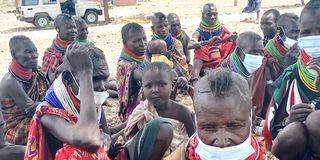How a 49-year-old deal has promoted peace on Kenya-Uganda border

A section of Lokiriama residents in Loima Sub-County on September 12, 2022 attending a chief's baraza. A 49 year old peace deal sealed by pastoralists communities from Kenya and Uganda has promoted peaceful coexistence at the border.
The Turkana County government will, starting today, host celebrations to mark the Lokiriama Peace Accord as part of Governor Jeremiah Lomorukai's development agenda of peacebuilding and conflict resolution.
The event, last held in 2018, will take place between September 19-21 in Lokiriama village, providing a platform for pastoral communities from four countries to review the peace pact for sustainable development in the borderlands.
The accord was signed 49 years ago and was negotiated by elders and local administrators in Kenya and Uganda in Lokiriama, Turkana County. It has cemented peace in the region, ending rampant killings and cattle theft.
Buried weapons
Locals say negotiations for the crucial peace agreement began in 1959 but the deal was not sealed until 1973. That is when the warring communities – the Turkana and Pokot in Kenya, the Tepes and Karamojong in Uganda, and the Merille, Nyangatom and Toposa in South Sudan – buried their weapons to end conflicts.
In the border village, located some 120km south-west of Lodwar, stands a monument that signifies the peace agreement.
The monument site is where guns, spears, arrows, traditional razor blades and knives were buried as a sign of the end of animosity among the warring communities that engaged in cattle raids and conflict over pasture and water, said Mr Emmanuel Imana, an elder and a veteran politician in the county.
"Many lives were being lost and the victims of cross-border conflicts lived in abject poverty, especially during drought. The fight took place between Mt Moroto in Uganda and Mt Loima in Kenya," Mr Imana said.
The monument has the shape of a battlefield, with an artistic impression of steep slopes of the two mountains, river beds and a flat area that resembles a fertile grazing field. The names of leaders from the two countries who facilitated the peace drive are also etched into the monument.

A police road block at Lokiriama village along Lodwar (Kenya) and Moroto (Uganda) road on September 12, 2022.
The Kenyan team was led by David Olocho, the Turkana district commissioner at the time, and six elders, while the Ugandan team was represented by Matheniko chief Akwalem Tioko and five elders.
Reformed warriors
Reformed warriors, such as Mr Joseph Moit, said annual celebrations to mark the peace deal have been a platform for promoting peaceful coexistence since the monument was officially unveiled in 2003 by Dr Chris Murungaru, the then minister of state in charge of internal security and provincial administration.
For 15 years, Mr Moit was among notorious warriors from the Turkana community who fought the Pokot in Kenya and the Dodoth, Jie and Karamajong in Uganda.
"Most members of my group of warriors were teenagers who were supposed to be in school. But since they lacked awareness on the importance of education, they engaged in raids and most were killed,” he said.
“Commemorating such peace deals provides a platform for many warriors to change through listening to leaders, security officers and reformed warriors like me."
Intermarriage
Peaceful coexistence has also encouraged intermarriage. Mr David Etabo, a Turkana, is married to Mary Ekai from his community and Mariam Lokui from the Karamojong.
“I run livestock and cereals businesses in Moroto and Lokiriama where I have homes. My two wives visit each other without any fears," said Mr Etabo, a father of six.
As celebrations to mark the peace accord kick off this week, Mr Etabo expects leaders to emphasise workable measures to sustain the treaty. To discourage retrogressive cultural practices, the measures include stiff penalties on communities believed to be aggressors and compensation for anyone killed in renewed attacks.
The Kenyan and Ugandan governments pledged to tackle insecurity along the border after former President Uhuru Kenyatta and Uganda’s Yoweri Museveni met in Moroto in the Karamoja region of Uganda in September 2019 to witness the signing of a memorandum of understanding on peace and development between the two countries.
Cross border programme
The Kenya and Uganda Cross Border Programme, a joint initiative supported by the United Nations country teams and managed by the United Nations Development Programme (UNDP), provides opportunities for better cooperation, coordination and peaceful coexistence.
The Uganda government has worked to get rid of illegal firearms, with more than 40,000 guns seized in a disarmament operation to boost peace and trade in the Karamoja region.
During droughts in Kenya, armed Pokot and Turkana pastoralists are not allowed to cross over to Uganda in search of pasture and water.
As dividends for sustained peace, the Kenya government has invested Sh750 million in mega dams in West Pokot, Turkana and Marsabit counties to address water scarcity along Kenya’s borders with Uganda and Ethiopia.
This was aimed at reducing over-reliance on Uganda's Kobebe Dam in Moroto, where pastoralists are usually exposed to renewed armed conflicts.
Kibish sub-county peacebuilding officer Achegei Abdi Adan welcomed the new county administration’s move to revive activities that allow representatives of warring communities to interact.
"Such platforms should also be utilised to award peace champions who have played a pivotal role in cementing peace, like local kraal elders, reformed warriors, security officers and peace officers who have tactfully thwarted attacks [and helped recover] stolen livestock," Mr Adan said.





